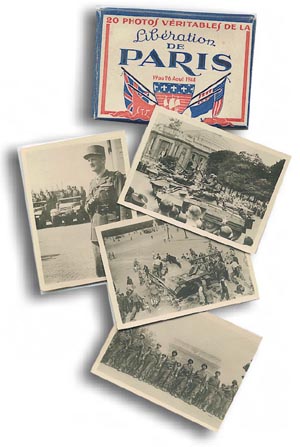
On August 19, 1944, Paris revolted. The rebellion was brewing and reached its peak with the approach of the Allied armies. The poorly armed, under-equipped Parisians would not have been able to hold out against the troops under the command of General von Scholtitz. If the actions of the allies did not lead to very rapid changes in the capital, the riot could have ended in a bloodbath. For de Gaulle, the situation is clear: Paris needs urgent help, and this is entrusted to the French division, the Second Panzer Division.
Flashed like gunpowder
The uprising had been brewing for many months, having really begun after the last meeting of the French National Committee for the Liberation (headed by Alexandre Parodi) and the National Council of the Resistance of Georges Bidault. August 18, 1944 hundreds of posters proclaiming general mobilization and signed by Colonel Rolle-Tanguy (head of the FFI * Paris) calling on the Parisians to revolt.
FFI - Forces Françaises de l "Intérieur - French internal forces, association of Resistance organizations in France, approx. trans.
Since August 19, the uprising continues with a general strike of the Parisian police, which occupies the prefecture. Under the military leadership of Colonel Rolle-Tanguy, head of the FFI of Paris, the uprising continues with the capture of the district's mayor's office and the commissariats. For the first time in 4 years of occupation, the first tricolors were raised. All FFI formations enter the battle, constantly harassing the German patrols.
At this time, General von Scholtitz, commandant of Greater Paris, receives an order to turn the French capital into a heap of ruins. Consul General of Sweden Raoul Nordling uses all his influence with a German officer to avoid massacre and destruction. Leclerc's division is more than 200 kilometers away, to the south. Time is running out, and the liberation of Paris is not listed in the immediate goals of SHAEF (Supreme Headquarters Allied Expeditionary Force - High Command of the Expeditionary Allied Forces - approx. transl.).
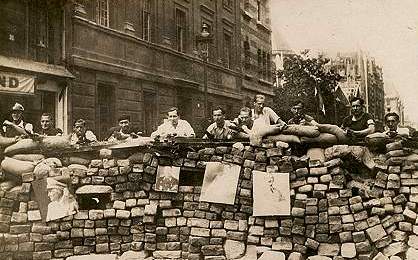
General position
Arriving on August 9, 1944 from the front in Normandy, where he commanded the 34th Army Corps, General Dietrich von Scholtitz had troops numbering approximately twenty thousand more or less combat-ready soldiers, 80 tanks, including about twenty "Panthers" and " Tigers", 6 self-propelled guns, 23 guns of 150 and 105 mm calibers, 35 anti-aircraft guns of 75 and 88 mm, as well as several units of the Waffen SS. In August 1944, the German army lost its superiority, in most parts the morale was low.
But the enemy military forces in and around Paris had many opportunities to crush the uprising. Since his arrival in the capital, the commandant of the Greater Paris had received nine orders to destroy Paris. However, he hesitated, because. was convinced that this order of the Fuhrer was criminal. Being both a military man and an art lover, Scholtitz believed that such destruction was useless - the imminent liberation of France was becoming more and more likely, and this would cause general indignation among the Parisians, who would turn the capital into a new Stalingrad, where his troops would suffer very heavy losses.
But Eisenhower is not disposed to a quick liberation of the French capital. The fighting could have been extremely difficult and would have claimed many human lives, because Paris would have to be retaken block by block. The main concern of the Allies remains the march on Germany and the speedy end of the war. Moving towards the city of light would greatly slow down the advance of the troops. In addition, the Parisians would have to be assisted in such quantities that would be enough for eight rifle divisions.
For these reasons, the liberation of Paris was not the immediate goal of SHAEF, which was under pressure from the head of the Free French (resistance organization, opponent of the Vichy government, which concluded a separate peace with Germany - approx. transl.) General de Gaulle. For him, the liberation of Paris, on the contrary, as a symbol of French unity, was a priority. Over France hung the shadow of AMGOT (the American organization responsible for organizing and regulating French affairs after the armistice), watching over France.
Charles de Gaulle was deeply convinced that only by entering Paris as the head of the Free French, surrounded by the French who had joined, could American hegemony be avoided. For the future head of state, tomorrow's France is looming at this moment. He could not join the opinion of Eisenhower, which was also the opinion of Roosevelt.
Sharing the wishes of General de Gaulle, but for purely patriotic and symbolic reasons, on August 15, 1944, Leclerc asked General Patton (Leclerc's division was then part of the 3rd Army) for permission to march on Paris. However, Patton and Bradley, having agreed to the meeting, gave no formal order to the French officer. On August 19, 1944, while the German 7th Army was going through its worst hours, Leclerc's division was fighting in the Argentana region. (city in Lower Normandy - approx. transl.) together with the English connection, was successful.
Until August 20, Leclerc is holding back. His unit came under the command of US General Jirou. Since the senior allies still did not give him the command to attack Paris and not wanting to show excessive initiative, he decides to send troops to Paris, commanded by Major Guillebon. This advanced unit, consisting of 10 light tanks, 10 armored personnel carriers and 150 motorized riflemen, is sent to the capital for reconnaissance. If de Gaulle, having learned about Leclerc's decision, agrees with him, General Jirou reacts sharply to this decision: the French general violated the instructions given to him.
Having given the order to advance immediately, Leclerc decided to go to meet General Bradley, the only one who could allow the 2nd Armored Division to march on Paris. August 22, 1944 at 10:30 a.m. Leclerc takes a seat aboard his Piper (small communication aircraft Piper J3 "Cub" - ed.) and flies to Laval. Bradley is unfortunately absent, but the unexpected presence of FFI Commander Galois (Chief of Staff de Rolle Tanguy) provides information about the plight in Paris. The Parisians hold out with exceptional courage, but casualties are high and they are short of weapons. If the allies do not immediately send their help, Paris will fall.
Galois clarifies that he has time to report to Bradley before he goes to see Eisenhower at Mance. If SHAEF does not take measures to supply Paris, the situation will change after August 20, 1944 (this is also the date of de Gaulle's arrival in Cherbourg). It can be assumed that it was the intervention of the head of the Free French and his English assistant, General Redman, that forced the Americans to yield, now they do not exclude the liberation of Paris before September 1944. Leclerc and Galois arrive at the Laval airfield. The general is tense, silent, time passes. The reason for this tension is simple: he disobeyed Jirou's orders and Giebon's column continues to advance towards Paris, while the rest of the division still has 200 km to go to the capital. At 7:15 p.m. Bradley finally strikes. "Leclerc is right!" - he throws ... - "We agree to break through to Paris" ...
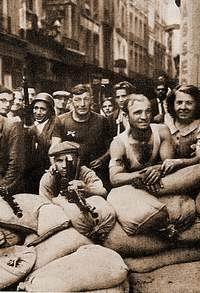
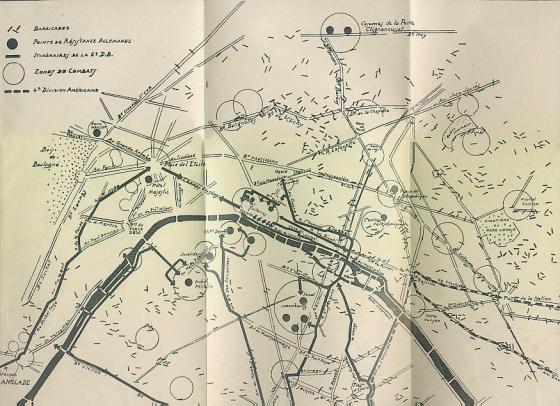
Leaflet:
Order for the Protection of the Population of Paris
The FFI and the people are called to fight for Paris. Our soldiers must use mobile tactics to fight the enemy. At the same time, there is a danger: the rapid movement of enemy tanks.
This danger is easy enough to avoid: prevent the Fritz from moving.
To this end, it is necessary for all Parisians, men, women and children, to build barricades, for which you cut down trees on avenues, boulevards and high streets. As for the small streets, they must be covered with barricades of whatever you find in your house and on the street, in order to guarantee your protection against the attacks of the enemy.
Under these conditions, the Fritz will be isolated and surrounded in several centers. They will not be able to start repression.
Everyone to the barricades!
Colonel Rohl, Commandant of Greater Paris
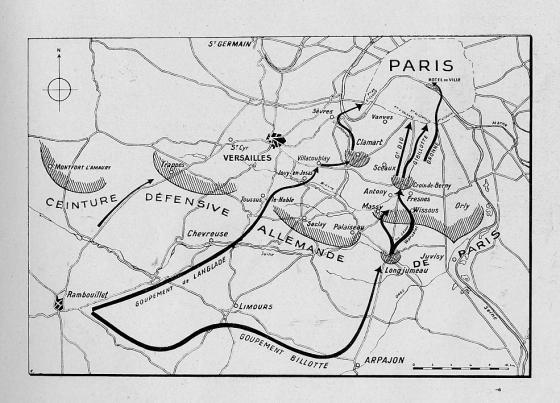
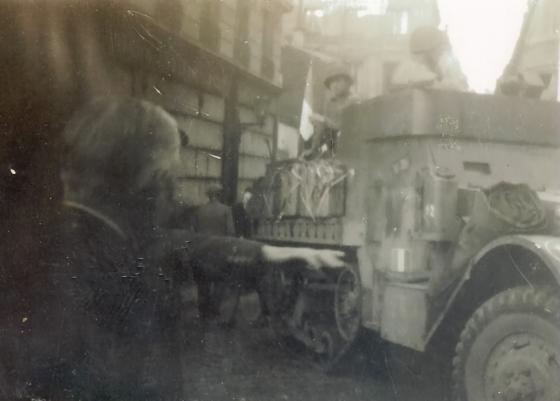
In the suburbs of Paris, the passage of the half-track M3 of the 2nd Armored Division
![]()
Entries from the operational log for August 24, 1944:
1. Combat mission
1-1 capture Paris
2-2 Hold Paris by occupying the roads between Ivry on the Seine and Neuly on the Marne
Advance units in a northeasterly direction from Paris
Locate spare parts in Paris
2. Intelligence
The enemy has a certain number of reference points with no connection between them. These anchor points are more densely located in the southwest of Paris.
3. Disposition
Main task - Tactical group "V"
a) advances in the direction of Arpaillon-Seaux - Paris, where he strikes the main blow, using small roads and avoiding large highways
b) Penetrates Paris towards the Pantheon, then crosses the Seine, enters the Vincennes-Charenton area and holds the bridges of the Marne between Ivry-on-the-Seine (inclusive) and Neuly-on-the-Marne (inclusive)
c) Then - to a comfortable position
Headquarters at the end of the task: Port Vincennes
Additional combat mission to bypass - Tactical group "L"
a) Proceeds in the direction of Dampierre - Chevreuse - Chateaufort - Toucs de Noble - Les Loges - Jouy en Josas - Villacoublay - Bois de Meudon - Pont de Sèvres.
b) holds Savres and advances in two subgroups to Versailles and towards Paris
c) At the end of the operation and after the change of parts of the reserve in Versailles, the whole group is put forward to the center of Paris (Place de la Concorde) to the mobile reserve
Headquarters: originally, Pont de Serves; then - Hotel Crillon in Paris
Tactical group "D"
a) Transferred to the 3rd Field Artillery Regiment at the disposal of Tactical Group V, stand by:
Or support the division by all means
Either supporting tactical group L, advancing in parts towards the Savre bridge
b) Clear the Parisian center
c) In case of rapid success of the operations of the various tactical formations "V" and "L", advances to Pantin, in the north of Paris.
Headquarters: City Hall of Panten
Morel-Deville unit: located in the old place and making every effort to simulate a direct attack in the direction of Saint-Cyr. At the end of the day - in reserve by order of Colonel Remy.
Air Defense: Batteries follow directly behind the formations to which they are attached, in readiness to organize air defense in the center of Paris and on the outskirts of Paris.
Engineering troops: parts of the reserve of engineering troops, under the command of the battalion commander and the commander of the engineering division, initially remain in Rambouillet and will be ready, according to a new order, to clear the direction of Rambouillet - Versailles - Paris at the end of the day.
Consolidation of Remy and reserve units: under the command of Colonel Remy follow to Versailles after his release and clearance of the direction, ready to receive any command to counterattack. Then follow to Paris (Longchamp)
4. Various traffic control units
Movement Control Platoon: Behind Tactical Group "V", then Cotolne Hotel, Paris
Main traffic control platoon: Rambouillet - Versailles (Lyceum Osh) - Longchamp.
Headquarters: Rambouye
5. Movement
One air defense battery at the disposal of group "V"
One air defense battery at the disposal of group "L"
Upon completion of the operation, both air defense units at the disposal of the general, Concorde Square
6. Air support
Main unit with "V" group
Secondary division with "L" group
7. Start of operation: 7 hours
General Leclerc, commander of the 2nd DB
The French division is ordered to capture Paris on August 24 and, if possible, to capture the bridges of the Seine, in the first place those leading from Genevilliers. In case of serious resistance, she must take up defensive positions. During this operation, she would be supported by General Barton's 4th US Rifle Division, which was advancing from the right flank through Joinville and Vincennes. Upon returning to his headquarters late at night, Leclerc orders his chief of staff, Captain Gribius, to advance. There is indescribable joy in the ranks of the Leclercs: many of them have been fighting together from the first minute and they have not seen the capital since 1940.
They fought in North Africa with an unwavering belief in victory. Now it is they who are entrusted with the honor of liberating the main city of their country. The strength of these feelings today is difficult to explain: one must remember the oath in Kufr * a few years earlier, in the middle of the desert with a handful of people, to understand the scope of what Leclerc did with "his" division and soldiers ready to follow him into hell. And so, in this very month of August 1944, the real strength of the people of Leclerc was revealed: their unity, despite the lived through and very different origins**.
* a group of oases and settlements in the southeast of Libya, where on December 21, 1940, then Colonel Leclerc, together with 400 supporters, gave the first battle to the Italians, starting the fighting of France on the side of the anti-Hitler coalition. Until that moment, France, led by the Vichy government, had been on the side of Germany. In Kufra, it was the French who bombed Leclerc as a rebel - approx. transl.
** Leclerc's division mainly consisted of Africans, which the French do not really like to remember - approx. transl.
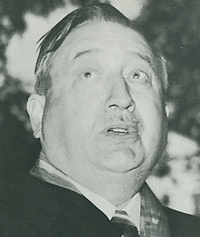
Raul Nordling (1882 - 1962) - Diplomat, Consul General of Sweden. With his numerous appeals to the German authorities, this humanist prevented numerous executions of resistance members. Using all his influence in von Schlotz's circle, he prevented the destruction of Paris. Declared an honorary citizen in 1958.
From 6 h 30 min. On August 23, the columns move in two directions: the connection of Langlade and Dio at Cee - Mortagne - Longgne - Chateauneuf - Maintenon - Rambouy - Saint-Cyr, the connection of Bilot goes through Carrouge - Alençon - Mamer - Nogent Rotrou - Chartres - Ablis - Orsay - Saclay - Bièvre - Vilacoubley.
Stretched out in a single column, the Second Armored Division is stretched like a giant snake for almost 500 kilometers. It is almost impossible to force such a group to travel more than 200 km. However, the "Leclerc guys" decided to carry it out.
At 13 o'clock the general sets up his headquarters at Rambouillet. On the afternoon of August 23, he is heading towards Paris, the division stops in and around Rambouillet, so that at 7 o'clock on August 24, start an offensive with two unrelated groups (Varabio and Langlade), which will have to pierce the German defense lines and, without trying to destroy them, continue movement: Leclerc bet on speed.
The first clashes take place in the very morning, pockets of resistance suffer losses: dug-in 88 mm guns destroy rather quickly three Shermans of the Massu group. Commander Massu continues the offensive, frequent skirmishes slow down the movement, but he manages to occupy the Bièvre valley by 14 o'clock.
Cadet Zagrosdski, whose brother had been killed a few days earlier, and who had insistently asked for the right to take his place, advances in his Sherman. As he sticks his head out of the turret to locate and destroy the anti-tank gun in front of him, the sniper kills him with a bullet to the head. Two brothers die in the same tower, at the same post. New encounters, very violent, are noted in the Meudon tree, where several French tanks are destroyed or damaged by camouflaged enemy armored vehicles. In spite of everything, the mission was accomplished and the troops reached the bridge of Sèvres at 21:35.
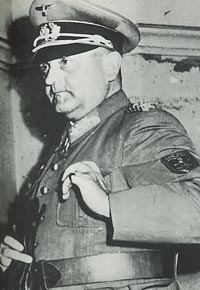
General Dietrich von Schlotitz (1894 - 1966) He began his career during the First World War. In 1939 he participated in the attack on Poland, then in a company in France. Then he was sent to the eastern front and took part in the siege of Sevastopol. He commanded an armored division in Russia in 1943-44, was appointed commander of the 32nd Army Corps in Normandy, where he was unable to prevent the Allied landings. Appointed commandant of Greater Paris in August 1944. His defiance of Hitler's orders was instrumental in saving Paris from destruction.
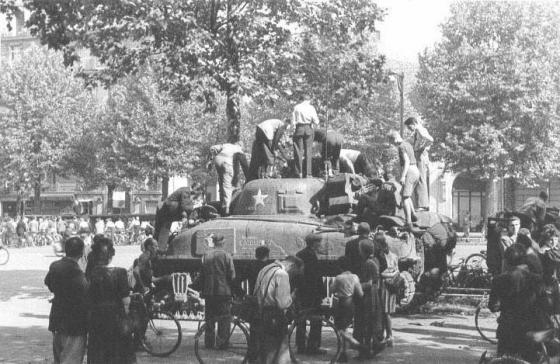
Group Bilotte (Group V) advances unopposed for the first two hours, then it lingers in front of Longjumeau, but disorganized resistance is quickly crushed. The column deepens into the knot of the German defense of the Croix de Berny. Heavy fighting is going on in Morangi and Wissou, armored vehicles and anti-tank weapons of the Germans inflict losses on Leclerc's troops. Wiss has to be subjected to shelling. Massy is also protected: Captain Bui's company was stuck there for five hours before breaking the resistance.
In the Croix de Berny, the enemy fire is especially strong, Colonel Varabio bypasses the pockets of resistance through Fresne, but the offensive is stopped at the prison, which the German political prisoners turned into a fortress. Street fights are now inevitable. Croix Burney and Fresne fell only at 19:00. At the end of the day, the 2nd DB advance is in line with their general's plans, but the men are exhausted (no sleep for two days), the tank tanks are empty, as are the ammunition depots.
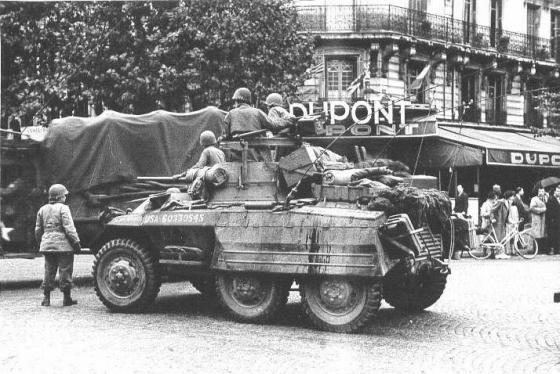
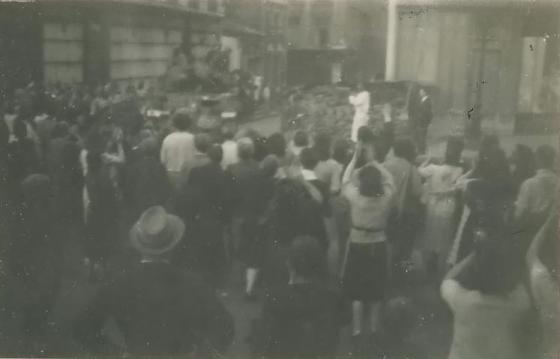
Meanwhile, first contact was made with the besieged Parisians. Leclerc sent his "Piper" to the capital in order to deliver a written message on a piece of paper. "Package" adopted in the prefectural yard. A few words of Leclerc on the leaflet seem like a bomb to those who have read it: “General Leclerc instructs me to tell you: hold fast, we are advancing. Signature: Colonel Krepin, artillery major of the 2nd BD.
Despite the words of support spoken to the Parisians and the information of Lieutenant Petit-Leroy (sent by General Chaban Delmas), everyone understands that the Parisian resistance has neither material nor military means to withstand long battles, on the other hand, there is absolutely no firm confidence in the desire von Scholtitz surrender.
Leclerc therefore wants to attack Paris without delay, but avoiding the high roads. He decides to get in touch with the Parisians to get intelligence. The case decided that Raymond Dronne, the commander of the strike group, would be the first to enter the capital and history.
Indeed, at the same time that Leclerc makes this decision, Captain Dronne rises to the pinnacle of glory at the head of his 9th company of the Chadian infantry regiment. (The regiment consisted mainly of Senegalese, Chadians and whites living in African colonies, exists to this day. Since 2008, it has been fighting in Afghanistan - approx. transl.). A Sartuan by origin, Raymond Dronne was born in Maillet (a city in the commune of Sartois in the center of France on the Loire River - approx. Transl.) in 1908. He was one of the first to join Leclerc. Since 1940, he was in all battles, seriously wounded in the Tunisian south. He commanded a company of Spanish volunteers who knew him only by the nickname "El Capitan".
Little inclined to conformism, Dronn christened his jeep with the curious nickname "Death to Mu*akam" ( Mort aux Cons) is not at all like the "chef", who repeatedly asked him to erase the inscription ... without success. Then he will limit himself to repeating to him often: “but why tell me, do you want to kill them all?”
When de Gaulle read the report the next day, he rewarded Dronne, noting with a sigh: “A difficult case! ..” However, now Leclerc asks his officer: “Dronne, what are you doing now?” "My general, I left the main direction of attack, I received an order, precise and categorical." The general's response is blunt: "This is an idiotic order, never follow idiotic orders."
Leclerc's instructions are clear: "Dronne, go to Paris, enter Paris, pass it if you want, tell the Parisians not to lose heart, that tomorrow morning the whole division will be in Paris" At 20 o'clock, the assault group moves off, led by three Shermans 501st Panzer Regiment: Montmirail, Champaudeur and Romilly, part of the platoon of Lieutenant Vitas, accompanied by fifteen half-track armored personnel carriers, and two engineering companies - a little less than 150 people, commanded by Georges Chevalier, a young man from Antony, who unexpectedly asked to take him.
Thanks to a young guide, L'Aye des Roses, Cachan, Arceuil, Fort Bicêtre, they pass quickly. At 20:45, the Dronna group enters Paris through the port of Italy. Having decided at first that the Germans broke through, then the Americans, the Parisians indulge in violent, frantic joy when they find out that we are talking about the “Leclerc French”. Dronn and his people are surrounded, crushed, they are embraced by a huge jubilant crowd that cannot be moved apart. The officer decides to make his way to the town hall in order to erect a symbol of national sovereignty. Accompanied by Lorenyan Dikran, a soldier of Dronn, they deepen into the capital through the Austerlitz bridge and the Seine embankment. A little later, at 21:20, they finally reach the Town Hall.
The equipment is located around the building, ready to repel any German attack. Dronn climbs to the first floor of the building where the headquarters of the National Council of the Resistance were located at that time. News of the arrival of Leclerc's troops in Paris spreads like wildfire. The bells of Parisian churches begin to ring, the great bell of Notre Dame began to ring first. The joy is short-lived, however, as heavy German machine gun fire disperses the crowd, reminding them that the occupiers are still there. Having met General Chaban Delmas, Maurice Dronne returns to his unit at night.
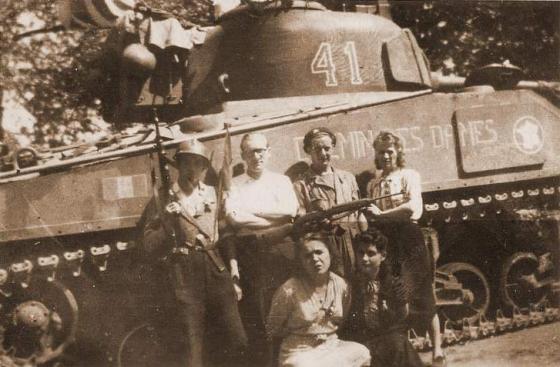
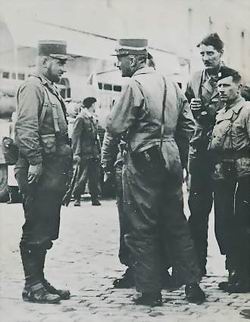
August 24, 1944, view of General von Scholtitz
“Don't think that it was easy for me to decide the fate of Paris. Circumstances forced me into a role for which, in fact, I was not created, Often I was at odds with my feelings and I had to constantly think about my soldiers. It would be absurd to believe that I acted according to a previously created plan. It's true, I followed the general line, but I had to react quickly to the situation, making decisions every time. I expected a massive enemy attack on the morning of August 24th. But this day, as it seemed to me, should have gone differently than the previous ones. No more news came from the outer ring, the telephone network no longer functioned, communication between the defending units and my headquarters was interrupted. There were no intermediate communication systems. We only listened to the growing noise of the fighting. At the entrance to the city, the brave but poorly equipped infantrymen and teenagers of the Labor Service bravely gave their last battle to the well-equipped and armed divisions. It was a hopeless struggle, as it was for all the German soldiers who had to stop the Western Front during the last months. While my thoughts were mainly with the soldiers at the front, the situation in the city was calmer than in previous days. For a long time there was no shooting. It was clear that the resistance forces were making contact with the army that was approaching... "from the memoirs of Dietrich von Scholtitz
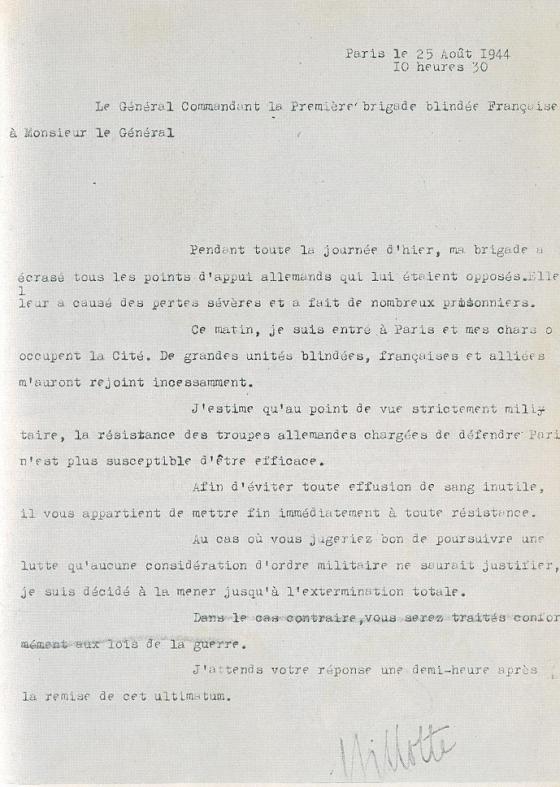
While Dronne was on duty in front of the town hall, Leclerc stopped at the Croix de Berny quarry, close to the road. The groups of Bilot and Dio were between Burg on the Rhine and Fresne, Colonel Langlade stopped his unit at the Sèvres bridge.
On August 25, it was necessary, avoiding high roads, to throw all their forces into Paris. Billot's group went to the police prefecture to join forces with Captain Dronn. Dio's two groups moved a little further east. The first unit under the command of Colonel Rouvillois - to the Quai d'Orsay to the Montparnasse train station, the Invalides Palace and the Chamber of Deputies. Colonel Noiret is in command of the second grouping and occupies the boulevards of the Seine to hold the bridges. Consolidation "L" finally heads to the Place des Stars and Place de la Concorde.
At 7:15 a.m. On August 25, 1944, the columns move off. After a quick march, the first armored vehicles enter the capital by 0900. Clashes break out at the Ministry of Foreign Affairs and the Bourbon Palace. Some tanks get stuck on the barriers that enclose the square of the Invalides. There, a Bureau second lieutenant will be mortally wounded when he tries to meet his parents. At the corner of Invalid Square and University Street, the Germans respond even more sharply. The Ministry catches fire, the Sherman is destroyed.
Colonel Noiret's unit was luckier, his advance only delayed occasionally. The main center of resistance was in Ecole Militer, where 250 fighters were cut off. The door of the building is pierced by a tank, infantrymen, reinforced by FFI, undertake a cleanup of the place, which will end only after an hour and a half of fighting, sometimes with the use of edged weapons. The roughly 200 survivors would slip away at the last moment from the mob and lynching, and would owe their salvation solely to the protection of Leclerc's men.
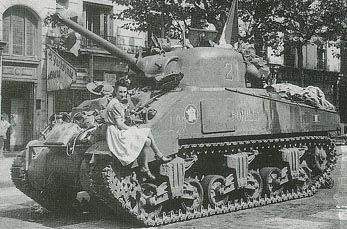
The Langlade formation left late due to supply problems and repelled a German attack at night, the enemy's losses amounted to 40 killed and 20 wounded. A small detachment clears Puto and Boulogne Billancourt, where a convoy of 25 trucks is completely destroyed. Kléber Avenue, an important enemy point of resistance, comes face to face with a Sherman squad without noticing their approach. Volleys of 75 mm guns quickly turn the column into a bonfire.
Colonel Billott leads his association to Paris without great losses. He arrives in the prefecture at 8:30. It is explained to him that General von Scholtitz seems to be about to retreat and that it is necessary to quickly make contact with him. Thus, Colonel Billott is at 14:00. a demand for surrender, where he agrees to defend the "general" by promising to keep him of value (something that absolutely will not be honored). This demand was conveyed by Consul Nordling, accompanied by Commander Ori, to the commandant of Greater Paris.
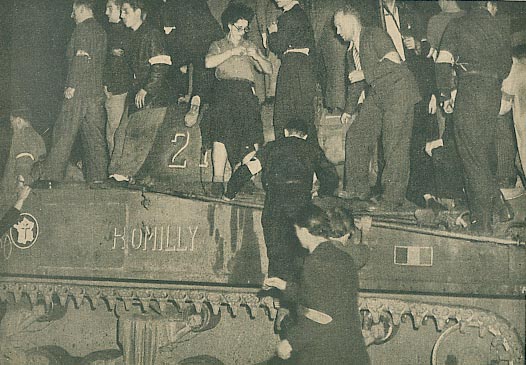
The delegation was met by Captain Füsch, who agreed to deliver the message to Lieutenant von Arnhem, von Scholtitz's adjutant. While the surrender of the Germans continues in many areas of the capital, the commandant of Greater Paris accepts the demands of the French on the condition that the Hotel Meurice, still defended by half a battalion of 200 people, surrenders with honors, that is, after a formal exchange of several shots. The attack on the building began at 2:30 p.m. by the Varabio group, which attacks in three columns: one towards the Tuileries, the second towards the Opera Avenue, while the last one remains in the center, capturing the Hotel Meurice.
There is more fierce resistance in it than the formal battle proposed by the German general. In the end, the points of resistance surrender one by one. In the Tueleries, 6 armored vehicles were destroyed, including 1 Panther and about twenty trucks. 160 vehicles and 350 people were taken prisoner. At the Hotel Meurice, Lieutenant Karshe, became the first French officer to make contact with von Scholtitz, who agrees to lay down his arms. He agrees to take a seat in Colonel Billott's car before asking him, "You were talking about an honorable fight... So, I've lost too many for an honor fight. You didn't follow the agreement. I don't know what I can do for you (editor's note: in fact, the 2nd DB during the capture of the German grouping lost 5 people killed, 16 wounded and missing).
At this time, General Leclerc has set up his headquarters at the Gare Montparnasse, this happens in the early morning and goes to the police prefecture to accept the German surrender. Von Scholtitz was brought there at about 3 p.m. 12 people are present at the German official surrender, among them General Leclerc, Chaban-Delma, Roll-Tanguy and Colonel Billott. The act of surrender will be signed by the French side on August 25, 1944 at 16:15. at Gare Montparnasse. Paris has been liberated by French units, but the fighting will actually last until 28 August. Leclerc's division would lose 130 men killed and over 300 wounded. The FFI lost approximately 500 killed and 1,000 wounded. Finally, the loss of the civilian population amounted to: 400 people were killed, 5500 were injured.
Paris paid a heavy tribute to freedom. On August 26, 1944, Leclerc's division passes through the Champs Elysees to the cries of a cheering crowd. Lions of Fezzan (historical area in Libya, which France recaptured from Italy in 1943 - approx. transl.), not without the support of General Jirou, entered one of the most beautiful high points of their unity. The American officer really refused to prevent the 2nd BD of General de Gaulle from leading Leclerc's people through the liberated Paris. Refusing to receive official permission, de Gaulle, true to his habit of speaking frankly, simply stated: “Gerow, I entrust my division to you. Let me take a few hours off."
